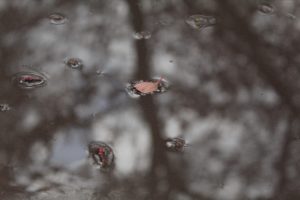While the beginning of April started off bleak with vegetation left colorless from the chilly winter months, over these past few weeks the warm weather and rainy days replenished the vegetation and restored it back to its verdant color. Although the sunshine and rainy weather is responsible for this recent change of scenery, the significance rain holds extends far beyond what meets the eye. For centuries rain has remained a staple resource for society from watering crops and preserving the ecosystem to acting as a renewable resource for harvesting power.
Weather has always held significance in society, even dating back to the times of ancient civilizations with different deities being associated with the weather and natural elements. For instance some of the most well-known deities like Zeus, from Greek mythology, and Thor, from Norse mythology, are believed to have control over thunderstorms. Another deity would be Tlaloc the Aztec god of rain, fertility, and water. For the Aztecs, Tlaloc was essential for the success of their season’s crops as they made offerings to Tlaloc to guarantee a thriving harvest. Similarly, in Aboriginal Australian mythology the Rainbow Serpent is believed to have created earth by forming lakes, rivers, and valleys. The Rainbow Serpent brings blessing of rain, though if the serpent isn’t respected it is said to have brought devastating droughts. The depictions of this snake are found in Aboriginal Australian rock art with some of this art dating back to be 6,000 years old.

While today rain isn’t regarded in the same ways it was during the times of ancient civilizations, the significance rain has on society is still important. Of course rain is still necessary for keeping soil healthy and growing crops to feed humans and animals, but the critical role this weather plays in the ecosystem extends far beyond its agricultural uses. Though the modern irrigation system helps water crops during times with less rainfall, the general idea of an irrigation system has been around since 6,000 BC and neither of these irrigation systems are able to act as a permanent replacement for rain.

Additionally with the help of dams the amount of water that flows through rivers, usually from rainfall or melted snow, is able to be regulated and decrease the risk for flooding. Interestingly, most of these dams also have hydroelectric generators, but there are very few dams that have been built for the sole purpose of producing electricity. Unfortunately these dams do have negative effects on the environment since the installation of them disrupts water flow, silt distribution, temperature, and pH of the river which disturbs plants and animals in the area. These dams also block salmon from traveling up river to lay their eggs, on the other hand, the U.S. The Department of Energy has been able to create fish ladders which have lowered the fish death rate from 5% to 10%, to under 2%. The nonprofit organization American Rivers has spent the past two decades documenting the challenges posed by the declining dam infrastructure throughout the country, but also celebrating success stories like the removal of three dams on the Klamath River in southern Oregon and northern California. More information on dams and other water-related topics can be found on the American Rivers website.
Though rain has many advantages, there are times when it can pose a threat to the ecosystem. For instance when rain condenses around small particles of dust, salt, smoke, or pollution, called cloud condensation nuclei. While rain droplets that form around brightly colored particles like red dust or green algae can form colored rain, certain pollutants like sulfur dioxide or nitrogen oxide can form acid rain. Acid rain can harm many aquatic animals and damage plants, by altering the pH level in water as well as dissolving the nutrients in the soil that plants need to grow. These pollutants, like dioxide or nitrogen oxide, can be released by volcanic eruptions or by human activities like through the burning of fossil fuels.
The inverse of rain, of course, is dust, and the antithesis of a nourishing rainstorm is a disruptive dust storm. Earlier in the spring states neighboring Nebraska, especially Kansas and Texas, were overwhelmed by dust storms that blanketed towns and created dangerous driving conditions on highways and interstates, including a 70+-car pileup that killed several people and left dozens more injured. A few days later Omaha was struck by a powerful storm that transitioned from rain to sleet to snow (in the form of a blizzard—our last snow day). Those who went out to shovel the snow after it had fallen were surprised to find a dense layer of brownish slush underneath the white snow, and when all of that snow melted a few days later a layer of dust coated roofs, cars, fields, and lawns—a layer of dust that remained for nearly two weeks until the next round of precipitation came through to wash it all away. The lesson is to be grateful for the flourishing plants we see today after a couple of heavier rounds of “April showers” because the future of Nebraska and other Great Plains states unfortunately looks more brown than green.

From the times of ancient civilizations till today, rain has played an important role in society as it serves as a way to produce energy, hydrate crops, and even has irregularities in nature with colorful and acid rain. So while the flowers begin to bloom and the grass becomes greener, every spring the significance of rain becomes more prominent and reminds everyone of the effects it has, whether good or bad.














